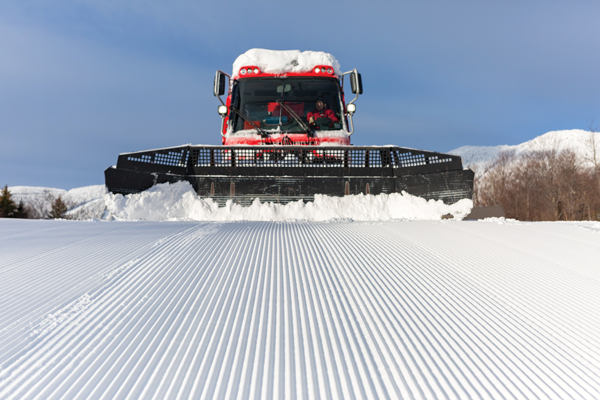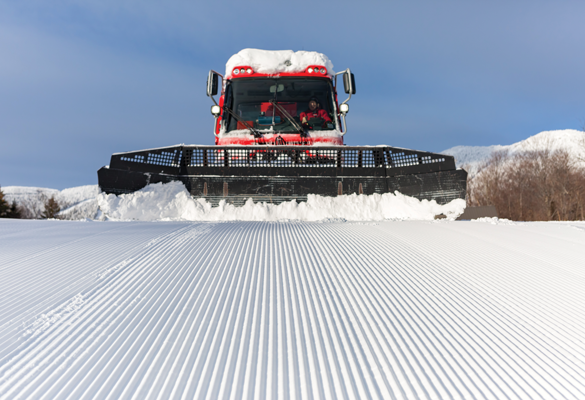To groom or not to groom, that is the question. In part, grooming is about skier preference and a mountain’s particular skiers and riders. Do they want three-dimensional terrain like bumps, or two-dimensional terrain like corduroy? But grooming is also about mountain preparation—daily snow placement and the handling of man-made snow—and recovery in response to the weather.
In good conditions, when the ground is frozen and the snow is soft, cold, and dry, the grooming plan is primarily about providing terrain for all abilities and desires. Midweek, when there’s less skier traffic and ability skews toward advanced and expert, Sugarbush grooms roughly 55 percent of the terrain nightly. But when weekends and holidays roll around, the plan gets more aggressive, with groomers laying corduroy on up to 70 percent of open terrain.
Where groomers really have their work cut out for them is in dealing with whales—the piles of man-made snow that form under a snow gun—and in responding to weather involving rain and warmth followed by a freeze, which creates challenging surfaces to ski. In both cases, explained Dan Paquette, a thirty-year Sugarbush groomer, “the most important rule is to wait for the snow to freeze or drain. With early-season snowmaking, sometimes temperatures aren’t ideal and the snow lands with some humidity in it. Driving a cat across wet snow can pack it solid, whereas letting the snow freeze before grooming will create a loose dry surface to ski.” This rule holds true whenever there’s humidity in the snow, whether from snowmaking, warm temperatures, rain, or ground moisture.
What exactly is the problem with grooming wet snow? The answer has everything to do with air. Grooming compresses the air out of wet snow, blocking pathways for humidity to escape. The result from driving a twelve-ton snowcat over wet snow that then freezes can be an almost impenetrable surface that’s hard for the cat to dig its teeth into—and even harder for a skier or snowboarder to carve turns on. Conversely, when the snow is allowed to drain and freeze before a snowcat’s pass, the porous surface is easier to break up into a packed powder or loose granular structure.
But on the day I headed out with Dan, freezing wasn’t a worry. In a steady April downpour, we went up and down Organgrinder, making corduroy with the winch cat. Why were we out grooming in the rain? “It’s a little less important to stay off wet snow in the spring,” Dan explained. “After all, it’s melting anyway, and someone’s going to want corn snow and corduroy. Plus, we have to fill in all these low spots,” he said, pointing to what looked like a boat’s depth finder between the cat’s seats. He explained that with new GPS technology introduced by Pisten Bully, he knows exactly how much snow is under the cat. And with nineteen feet at one location, and two feet at another, it was time to shift some snow around. Then Dan chuckled. As a longtime veteran on the grooming team and a Sugarbush skier for even longer, he didn’t really need that fancy GPS—he already had a sense of the depth of the snow. But he does see the technology’s benefit to the resort. As we passed over another low spot, Dan said, “All the data passes back to Mountain Operations. They’d look at this and turn a snow gun on right here if it were early season.” Efficiency Vermont, a nonprofit dedicated to reducing energy consumption, is exploring subsidizing the technology for the state’s resorts. Knowing where to make snow and where the groomer should push it helps reduce energy costs by making the operation more efficient.
As we descended from our final pass, the wind was picking up. “Wind’s tricky,” Dan said. “Prior to wind we’ll pack loose powder down to keep it from blowing away, and we’ll also avoid grooming something that’s set solid so we don’t make a surface that could be blown away.”
Dan grew up as a dairy farmer; now he considers himself a snow farmer, moving snow around for the skiers and riders—including himself—to graze on. The next day, as I laid an edge into the spring corduroy, I thought to myself, Thanks, Dan. This is a herd I’m happy to be part of.


